TechRadar Verdict
This hybrid laptop goes for the best of both worlds, but cuts corners on storage space and keyboard quality to get there.
Pros
- +
Great price
- +
Good battery life
- +
Solid build
Cons
- -
Limited storage
- -
Slow
- -
Last-gen hardware
- -
Poor keyboard
Why you can trust TechRadar
Acer has upped its game in recent years, and it's easy to forget that just two years ago the Taiwanese giant made its money peddling identi-kit budget laptops by their millions. The company has since turned around its reputation and is responsible for the glorious Acer Aspire S7 - one of finest Ultrabooks out there - and has also got chins wagging about the Acer Iconia W3 - the world's first 8-inch Windows 8 tablet - as well as the Acer Aspire R7 and Acer Aspire P3.
The devices hit at a busy time, with most manufacturers releasing their second bite at the Windows 8 cherry, with Samsung finally throwing its weight behind the new OS with its Ativ range, Sony doing impressive things with the Vaio Duo 13, and Asus about to revamp its VivoBook operation.
The first of the new slew of Acer devices to hit the shelves is the Aspire P3, a Windows 8 slate with keyboard docking station which is not unlike last year's Iconia W5. It's another attempt to woo buyers by offering the convenience of a tablet but the usability of a full-blooded laptop, a challenge that every manufacturer of Windows-based hardware has attempted without success.
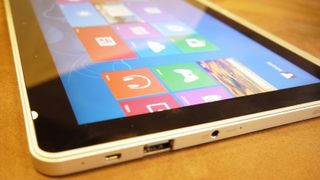
The reason for the continued struggle is that the inconvenient constraints of that thing called "physics" mean that every feature requires a compromise. Downsizing to make a tablet-laptop portable means you sacrifice comfort, but adding the components necessary for powerful computing adds weight, and miniaturising everything costs money. The result has been a series of cumbersome devices featuring confusing docks, which weigh the same as a laptop and cost a ruddy fortune.
Acer has managed to answer one of these complaints immediately with the Aspire P3. The £529 (around US$820 / AU$900) asking price for the entry-level model is a fair deal, and makes it one of the best value devices on the market. Surface RT is cheaper, but while that has enjoyed a price cut to just £250 / US$350 / AU$390 recently, the Windows RT operating system means it's in a lower division to the full Windows 8 Acer Aspire P3 altogether.
Despite the low price, the Acer Aspire P3 tablet itself is actually very well made. At 900g (1.98lbs) - or 1.25kg (2.76lbs) with the keyboard attachment - it's certainly heavy compared to the 670g (1.48lbs) iPad 4, but there's USB and HDMI ports, a good quality feel and great looks.
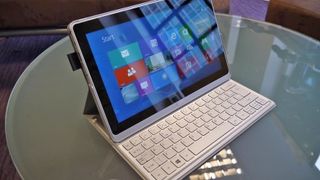
Our only complaint is the chunky design, measuring 258.5 x 167.5 x 18.7mm (10.2 x 6.6 x 0.74 inches), especially since Samsung is boasting that its Ativ Tab will boast a better spec in a case that's about 33% lighter.
With a good price and excellent build quality, can Acer solve the usability question and pack the Aspire P3 with a good enough spec to make this a killer tablet?
Specifications
With the entry-level Acer Aspire P3 model retailing for just £529 (around US$820 / AU$900), compromises will have to be made somewhere. The first result of Acer's frugality is found at the machine's heart.
Costs have been saved by using a previous generation, entry-level processor. The Intel Core i3 3229Y is the chip of choice, which is only a dual-core chip (with four threads) clocked at a mediocre 1.4GHz. It's one of the lowest powered Intel Core processors you'll find, but it's head and shoulders above some of the Atom processors you'll find.
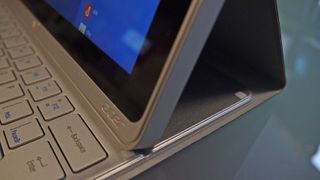
Elsewhere there's 2GB of RAM, which is the minimum you'd need for a good experience, and graphics are handled by the onboard Intel HD 4000 chip, which is the norm on hybrid tablets or Ultrabooks.
The 60GB SSD drive supplied is also minimal, and raises questions about whether the Acer Aspire P3 could be used as a primary machine for your business or family. With just 60GB available and no SD card slot, storage is minimal here, and when we started the Acer Aspire P3 up for the first time, we were told that only 21GB was free to use - which is a perilously small amount.
The screen is also mediocre, with the 11.6-inch panel packing a 1366 x 768 resolution. Most of the Aspire P5's more expensive competition now ships with Full HD 1920 x 1080 screens, and when the display is 11 inches across you do notice the difference.
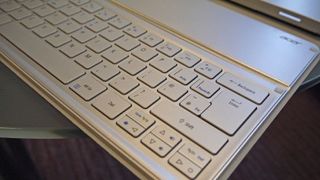
As well as the impact on clarity and picture detail, the Acer's panel also lacked vibrancy, and colours looked pale and washed out - although the high 400nit brightness does help. Those wanting to use their tablet for movies or picture editing might want to consider spending more.
If you don't believe us about the cost-cutting theme yet, the supplied cameras are further evidence. The rear camera is just 5-megapixels, which we'd consider to be a decent omission. However, the front-facing camera which is used for Skyping and video calling only supports 720p video, which will be sufficient for occasional users, but again, you will notice the impact.
The Acer Aspire P3 packs in a 5280mAh battery, which is par for the course on modern tablets. We'd be expecting around five hours of use from a battery cell that size, so check the Performance section of this review to see how it fared.
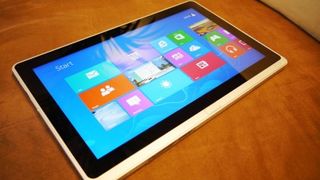
As well as the entry-level Core i3 model that we reviewed, an Intel Core i5 version of the Acer Aspire P3 is also available, priced at £699.99 / US$899.99 / AU$1,199 with 120GB of SSD storage and 4GB of RAM. There's also a Core i3 version with a 120GB SSD and 4GB of RAM available for £629.99 / AU$999 (around US$980).
US customers get an Intel Pentium processor on their entry-level Acer Aspire P3, plus 60GB SSD and 2GB of RAM, for US$599.99.
While the price is right, however, Acer hasn't done such a good job with the dock. While many keyboard accessories connect to the laptop physically and even work as an extra battery to aid longevity, the Acer Aspire P3's keyboard is simply built into the case and works using Bluetooth.
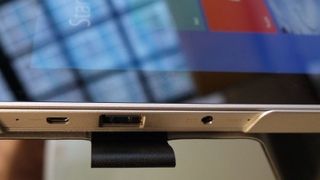
This is doubtlessly a cost-cutting exercise, but it makes the keyboard a sticking point for us, for a multitude of reasons, which we'll outline.
Firstly, it's thin and uncomfortable, flexing heavily even on hard surfaces and often mis-registering key presses. Then there's the way it holds up the tablet, propping up the screen at a steep angle that there's no way to adjust and very hard to balance on your lap. Think that's our only gripe? We haven't got started yet.
Acer says the battery will last a week, but if you forget to long-press the power button to turn it off you get a couple of days. If it gets low on battery, you need to dig out a small cable to charge it from the tablet, which in turn will need to be charged. The Bluetooth connection is prone to dropping, because it's Bluetooth. There's no trackpad on the keyboard, which would still be handy for documents and working in older programs even if you have a touchscreen.
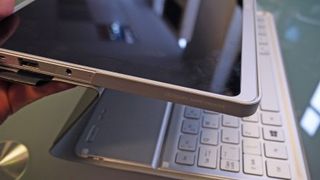
As you can see we didn't really like the keyboard, and we didn't even get on to saying how difficult it is to remove the tablet from the bendy plastic case or how boringly corporate it looks.
Performance
Benchmarks
Cinebench: Open GL: 7.07fps. CPU: 1.11pts
3D Mark: Ice Storm: 20,449. CloudGate: 2358. Fire: 354
Battery Eater: 250 mins
The Acer Aspire P3's Intel Core processor was never going to set any records in our testing labs, and a score of just 1.11 in Cinebench backed this up. This is one of the lowest scores we've seen from an Intel Core-based chip, and is a direct result of both the lack of cores the low clock speed. These two factors combine to make for disappointing performance.
Benchmarks mean little without real-world testing, but we did feel the lack of raw speed all over the Acer Aspire P3. It wasn't stuttery - something those who own older Windows laptops might have experienced - but there's a general lethargy across the whole operating system, which regularly keeps you waiting.

Apps take a long time to open, and menus would often sit for a couple of seconds before springing into life. One of Windows' virtues is its ability to run well on lesser hardware, and while the experience rarely missed a beat, some users might be frustrated by the loading times.
Graphics power on the Acer Aspire P3 is pretty much non-existent. All of the graphics and pixel-pushing is left to the onboard Intel chip, and with barely enough power to keep things running smoothly the Intel HD 4000 graphics chip was hardly likely to ace our frames per second tests.
Most of our renders chugged along at around 10fps, dropping to below 3fps for anything resembling an intense modern PC title. If you were wowed by the idea of a Windows PC in a tablet form for playing games on the train, you will seriously need to rethink your expectations.
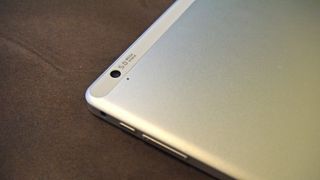
However, for most people, the Acer's graphics capabilities will be sufficient. Games from the Windows Store still played well, not that there's a huge selection to choose from, and 1080p video didn't miss a beat during extensive playback. A light smattering of app-based games and the occasional movie or TV show rented from the Windows Store is all most users will need.
With low power often comes savings in battery life, and this is one area the Acer Aspire P3 prevailed. A score of 250 minutes in our tests, which involve looping high-def video and simulating office tasks, show it's got the stamina.
This is the kind of battery life we'd expect from newer fourth generation Intel PCs, so to find it on this third generation tablet is pleasing. It means you're getting next generation longevity for less, but the pay-off is the pedestrian speeds.
Verdict
Overall the Acer Aspire P3 is a decent Windows 8 tablet that will suffice for those looking for a portable tablet that runs Microsoft Office, their favourite programs and can support external displays and USB devices.
With its bulky build, poor keyboard and mediocre performance it's another Windows 8 hybrid that's neither suited to replacing your existing laptop, nor providing an exciting entertainment experience that might rival Apple's iPad. However, if the benefits of Windows 8 are what you're looking for in a secondary device, the solid build and good price make the Acer Aspire P3 worth consideration.
We liked
The strong build of the tablet and bright screen are both excellent features of the Acer Aspire P3, as is the decent battery life. At 11.6 inches it's certainly usable for working and we even enjoyed surfing the web on the sofa, if only in short bursts.
We disliked
Despite the decent tablet design, it seems that's where the design team blew the budget. The keyboard adds nothing, is devoid of useful features, and isn't a particularly useful keyboard. As a user, you're better off without it.
Our second major complaint is storage. With no microSD slot and only 23GB of usable space, the Acer Aspire P3 is flawed as a primary device. And if you can't extract these benefits from Windows 8, then you might as well pick up a 32GB iPad 4, where the hardware is better in almost every respect.
Final verdict
If you're looking for a Windows tablet for working on the move, the Acer Aspire P3 has a lot to offer at a great price. However, minuscule storage space and low quality keyboard mean it's still a poor replacement for a laptop.

Wear OS 5: what we want to see, and all the leaks so far

The obscure little PC that wanted to be a big NAS — super compact Maiyunda M1 doesn't cost that much, offers up to 40TB SSD storage, runs Windows and has 4 Gigabit Ethernet ports

Image site Abload going offline reminds me of how much online content we've permanently lost
